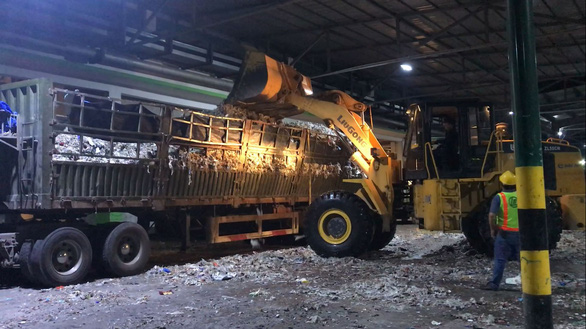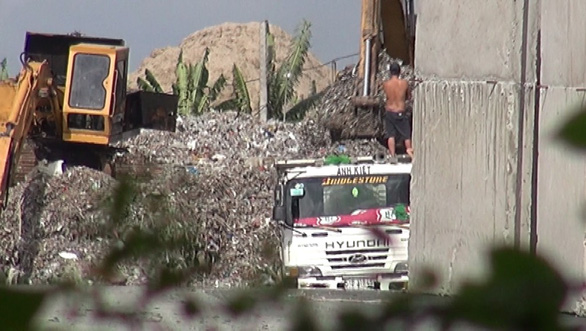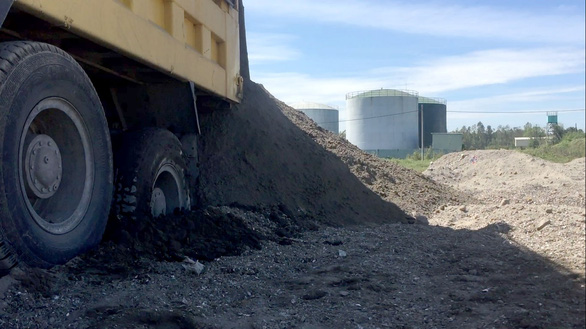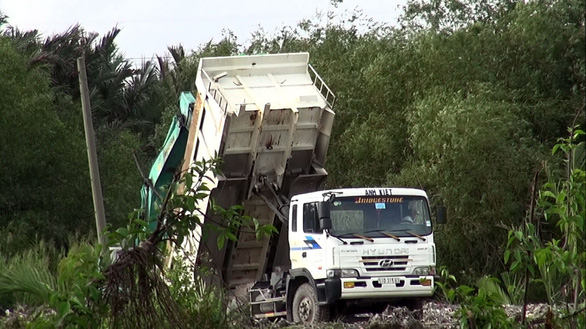Thousands of metric tons of solid industrial waste from a paper mill in the Mekong Delta province of Hau Giang has been illegally used as fill material for land reclamation without proper treatment, posing serious health and pollution hazards.
A company contracted by the Hong Kong-invested Lee & Man paper mill has been secretly sending the hazardous material to land reclamation sites in Ho Chi Minh City and the southern city of Can Tho, an exclusive investigation by Tuoi Tre (Youth) newspaper has found.
At the Lee & Man facility in Hau Giang, trucks frequent its waste reception area every day to receive waste from the factory’s production.
The trucks belong to the Bac Nam Environment and Engineering Co. Ltd., which is contracted by Lee & Man to transport its waste to treatment centers in the southern provinces of Ba Ria – Vung Tau and Dong Nai.
Bac Nam Company is paid VND900 (US$0.04) per kilogram of solid waste and VND1,150 ($0.05) per kilogram of sludge it takes from the paper mill, according to a contract signed between both parties in May 2018.
The company, in turn, has to pay the treatment centers around 30-50 percent of the money it receives from Lee & Man upon dropping the waste off for treatment.
In reality, however, Bac Nam Company has avoided paying the treatment cost by secretly transporting a part of the waste to Ho Chi Minh City and Can Tho, where the hazardous material is sold to any real estate developer that needs cheap fill dirt to reclaim land for their construction projects.
According to figures provided by Lee & Man, around 4,000 metric tons of its factory waste has ‘vanished’ without any trace after being handed over to Bac Nam Company between October 2017 and August 2018.
The material was in fact used in numerous land reclamation projects.
 |
| Factory waste from the Lee & Man paper mill in Hau Giang Province in southern Vietnam is loaded onto a truck. Photo: Tuoi Tre |
Where does the waste go?
Industrial waste from the Lee & Man paper mill that is not taken to treatment centers is either collected at a landfill in Binh Chanh District, Ho Chi Minh City or brought to Cai Cui Port in Can Tho.
At the Cai Cui Port, around six to seven trucks arrive every day to dump waste onto an open field for a land reclamation project.
Much busier activities are reported at a 10,000-square-meter landfill along Nguyen Huu Tho Street in Binh Chanh District, where mountains of industrial waste from the Lee & Man paper mill are collected before they are transported to different construction sites in the city to be used as fill dirt.
Plastic bags, broken glasses, scrap metals and paper pulps pile up into massive dunes of garbage towering up to ten meters high.
 |
| Industrial waste piles up at an illegal landfill in Binh Chanh District, Ho Chi Minh City. Photo: Tuoi Tre |
In the period of nearly one year when Tuoi Tre journalists kept track of activities at the landfill, there was no sight of authorities inspecting the place.
According to Dr. Vu Ngoc Long, chairman of the scientific council of the Southern Institute of Ecology, the burial of solid industrial waste in residential areas without any treatment poses serious health and pollution hazards.
Such material takes centuries to decompose, while without any preventive measures leakage from the waste can easily penetrate the groundwater system, poisoning a crucial source of water for household use in the city.
Chemicals such as lead, arsenic, mercury and phosphorus in factory waste cannot be naturally excreted from the human body and can lead to skin infections, cancer and sepsis, Dr. Long said.
 |
| Industrial waste is dumped at the Cai Cui Port in Can Tho City in southern Vietnam. Photo: Tuoi Tre |
 |
| A truck dumps industrial waste at an illegal landfill in Binh Chanh District, Ho Chi Minh City. Photo: Tuoi Tre |
Like us on Facebook or follow us on Twitter to get the latest news about Vietnam!





















































